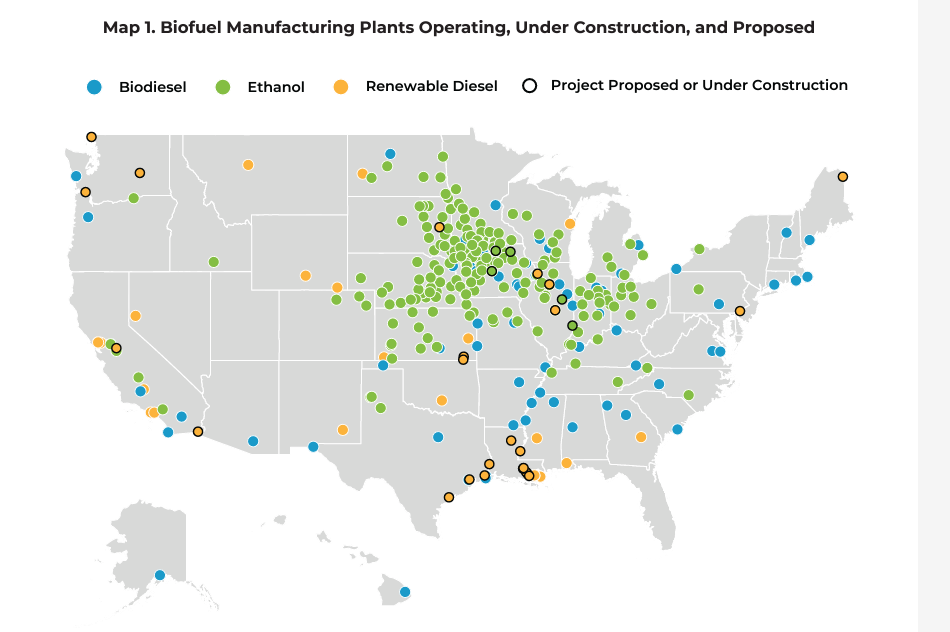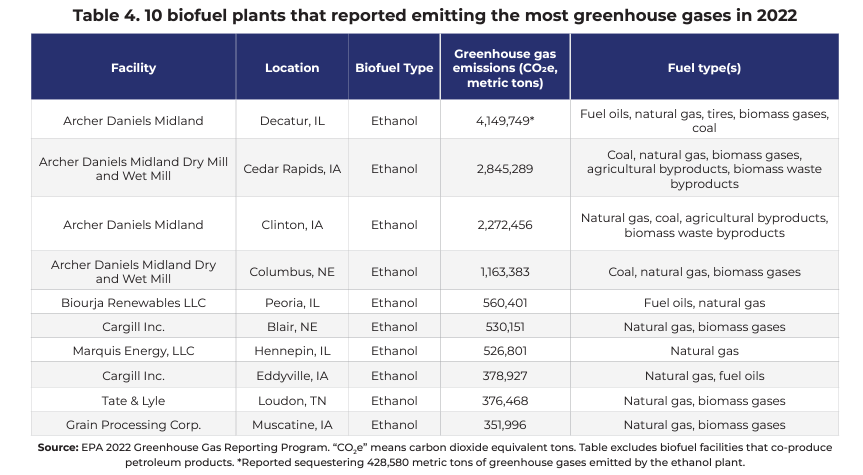By Dana Dragmand. New Leads
Biofuel production releases harmful air pollutants roughly equivalent to those produced by oil refineries, and for some types of dangerous pollutants, such as formaldehyde, the emissions from biofuel production are much greater. New reports find.
The assessment, conducted by researchers at the Environmental Integrity Project (EIP), an environmental watchdog group, looked at emissions from 275 ethanol, biodiesel and renewable diesel production facilities in the U.S. The researchers found that while these facilities frequently violate air pollution permits, they also benefit from federal policy supports such as legal exemptions and fuel blending mandates.
As the biofuels industry continues to expand, with more than 30 new facilities under construction or planned, the report warns that the industry should be viewed as a threat to public health and requires stronger regulatory oversight from the Environmental Protection Agency (EPA), according to the EIP.
“Despite its green image, the biofuel industry emits alarming amounts of harmful air pollutants, putting communities at risk — a problem made worse by EPA’s lax regulations,” said Courtney Barnhart, EIP’s research director. statement.
According to the EIP report released Wednesday, biofuel production emitted 12.9 million pounds of hazardous air pollutants in 2022. Oil refineries emitted 14.5 million pounds of hazardous air pollutants that same year, according to data from the EPA’s Toxic Release Inventory.

(Source: Environmental Conservation Project Report)
According to the EIP report, emissions from biofuel plants were significantly higher than oil refineries for four harmful pollutants: formaldehyde, acetaldehyde, acrolein, and hexane. In 2022, biofuel facilities reported releasing about 7.7 million pounds of hexane, more than 2.1 million pounds of acetaldehyde, 235,125 pounds of formaldehyde, and 357,564 pounds of acrolein. By comparison, oil refineries that year emitted 2.6 million pounds of hexane, 10,420 pounds of acetaldehyde, 67,774 pounds of formaldehyde, and zero pounds of acrolein.
Formaldehyde is carcinogenic to the human body ( International Agency for Research on Cancer) and Acetaldehyde According to the EPA, it is probably carcinogenic to humans. Acrolein “Toxic to humans by inhalation, oral, or dermal exposure” It may cause Upper respiratory tract inflammation, nausea, vomiting, shortness of breath, Hexane Exposure can affect the central nervous system and cause eye and throat irritation.
As the new report explains, “These same four pollutants also contribute to the formation of ground-level ozone and smog that are linked to a variety of respiratory diseases. They also produce fine, soot-like particles that can trigger heart attacks and asthma attacks.”
The biofuel industry is the largest source of acrolein emissions in the United States, with Cargill’s ethanol plant in Blair, Nebraska, the nation’s largest acrolein emitter. The facility reported releasing 34,489 pounds of the toxic pollutant in 2022, according to the EIP. Researchers also found that the nation’s largest source of hexane industry emissions is the Archer Daniels Midland (ADM) ethanol and grain processing facility in Decatur, Illinois. The plant released 2.2 million pounds of the pollutant in 2022.
Neither ADM nor Cargill responded to requests for comment.
Jeff Cooper, CEO of the Renewable Fuels Association, took issue with the EIP report, saying it had a “fundamentally flawed” understanding of the U.S. renewable fuels industry and conflated ethanol, biodiesel and renewable diesel production. He said, for example, that it “misattributes hexane emissions to fuel ethanol,” even though hexane is never used in the ethanol production process anywhere in the U.S. Furthermore, he said, the companies listed as having the highest emissions are not ethanol plants themselves, but wet mills where ethanol is just one product among many. More than 90 percent of fuel ethanol is produced in dry mills, Cooper said.
“Furthermore, U.S. ethanol facilities are highly regulated in terms of emissions, and producers comply with all federal and state emissions limits. When violations are found (which is extremely rare), producers take immediate corrective action and quickly come into compliance,” he said.
Biofuel production produces harmful air pollutants as well as greenhouse gas emissions that contribute to dangerous climate change. U.S. biofuel plants emitted more than 33 million tons of these climate pollutants in 2022, the report found, equivalent to more than eight coal-fired power plants operating 24 hours a day. “This is a remarkable amount for an industry that describes itself as climate-friendly and environmentally sustainable,” Bernhardt said at a press conference Wednesday.
Previous studies have also cast doubt on the perception that these plant-based fuels are a more environmentally friendly alternative to petroleum. 2022 Survey For example, he suggested that corn-based ethanol production is not carbon intensive. Perhaps even more so than gasoline.Especially when considering the full life cycle impacts, including fertilizer consumption and land use conversion.

(Source: Environmental Conservation Project Report)
The United States is the world’s largest producer of biofuels, producing 18.5 billion gallons in 2022 alone (about 40% of the global total). The majority of that production, about 15 billion gallons, is ethanol, made primarily from corn and soybeans. As the report points out, nearly half of the soybeans and more than a third of the corn grown are used for fuel production, not for food.
The U.S. biofuel industry has grown rapidly over the past few decades, supported by billions of dollars in government subsidies and numerous federal policies and incentives. And the industry continues to expand, with at least 32 new or expanded facilities under construction or planned, according to the EIP report, which could increase production capacity by 33% from 2023 levels. Much of this planned new production is for so-called “sustainable aviation fuels” made from wood or plant materials.
But a new study finds that existing biofuel facilities have a poor track record of complying with environmental regulations and are significant contributors to climate and harmful air pollution, potentially endangering the health of the mostly rural residents who live near or downwind from the plants.
The ADM plant in Illinois, one of the largest biofuels facilities in the country, was the industry’s biggest polluter in 2022, emitting 4 million tons of greenhouse gases and about 3 million pounds of hazardous air pollutants.
“People near Decatur, Illinois, are constantly exposed to air pollution that harms their brains and causes dizziness and nausea. ADM’s ethanol plant emits more greenhouse gases than places like oil refineries in Illinois.” Said Robert Hirschfeld, director of water policy at the Prairie Rivers Network, an Illinois-based environmental group.
Elliot Clay, director of land use for the Illinois Environmental Council, argued at a press conference that the industrial agriculture sector “continues to greenwash biofuels.” Said This new report helps expose the truth: people in central and southern Illinois are “living with shocking levels of exposure to toxic industrial emissions.”
But as the report explains, biofuels are not subject to stricter air pollution regulations, and the EPA removed corn-based ethanol from the list of facilities subject to stricter pollution standards under the Clean Air Act in 2007. The report also found that more than one-third of biofuel plants (with available data) failed Clean Air Act air pollution compliance as measured by a “stack test,” and 41% of facilities violated their air pollution control permits at least once between July 2021 and May 2024.
In addition to stricter enforcement, the EIP report recommends that federal regulators eliminate exemption permits for ethanol manufacturers, improve monitoring and management of hazardous air pollutants from biofuel facilities, require producers to improve the accuracy of emissions reporting, and eliminate mandates such as biofuel subsidies and the Renewable Fuel Standard.
“The environmental benefits of this government support are questionable at best,” Barnhart said.








